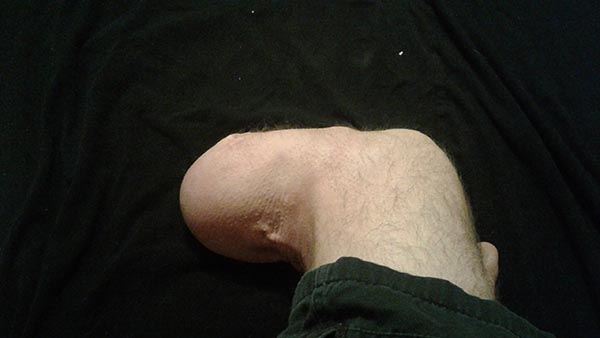A Cure for BIID? This Man Thinks He Found One
Part II
People with body integrity identity disorder struggle with a desire to amputate their limbs or become disabled. This is the story of someone who followed through with that task — and what happened next.
By Jessie Schiewe
What if you hated your left foot so much you it took over your life? (Art: Ivan Chadinski)
Sure, he might have half-a-leg less than most people, but for John, life has improved since he became an amputee.
“I like being the one-legged guy,” he told me over email.
Even though the lower half of his left leg is missing, John can still walk, drive a car, and hike in the woods like he used to. Some activities, like jogging, in which he wears a running blade on his stump, are now even more enjoyable than they were before.
“It's more fun than when I had two legs,” he said.
But what differentiates John — whose name has been changed to protect his identity — from other amputees is the fact that he didn’t involuntary lose his leg. He wanted it removed from his body — and so he smashed it to smithereens with a rock.
I discovered John through Reddit while researching a rare condition called body integrity identity disorder (BIID). People with BIID have obsessive desires to amputate healthy limbs or other body parts to relieve suffering. They might feel numbness and a lack of connection with their hand or feel “over-complete” by having all of their senses. Living without the problematic body part is the goal, and amputation is often seen as a means to an end.
BIID occupies a medical gray area, with opposing viewpoints as to whether it is a psychological or neurological condition. Therapy and antidepressants can help soften their compulsory thoughts, but there is no known cure for combating it — other than amputation.
For ethical reasons, doctors will not perform voluntary amputations, so most people with BIID live their whole lives stuck with a body part they loathe. Only very few take matters into their own hands, provoking amputations by harming themselves so badly the body part needs to be surgically removed.
That’s what John did. In the Reddit group where I discovered him, he posted the full story of his lifelong struggle with BIID and his eventual decision to take matters into his own hands by forcibly injuring himself to such a degree that he required an amputation.
It happened in the early 2000s, when he was in his 20s. John did careful research, choosing a wooded nature spot that wasn’t too far from a hospital to do the deed. After finding the largest rock he could carry, he smashed his left foot repeatedly until it looked mangled enough that he’d never be able to walk on it again.
At the hospital, John told everyone the lie he continues to tell to this day: that he was rock climbing and fell.
They believed him, and soon doctors confirmed what he wanted to hear: that his lower leg was destroyed beyond repair. It was amputated the next day, turning the page on a new chapter in John’s life.
John’s left leg was chopped off a few inches below the knee.
In his Reddit post, John claimed that since the amputation, he has been cured of his BIID. The hatred he had for his limb and the persistent, niggling desire to remove it vanished after the surgery.
Before John, I’d talked to others who struggle with BIID. Many of them fantasize about chopping off their limbs themselves, yet none have followed through like John, largely due to safety concerns that they’ll die doing it.
My curiosity piqued, I reached out to John via private message and asked if I could interview him. Because of the shame and lack of understanding around BIID, many with the condition are reluctant to speak publicly about it. To protect their identities, none of the people I spoke with previously gave me their real names.
John was no different. And, because he had a lie to maintain, he was even more cautious about speaking with me.
“My wife, along with everyone else I know, believes the story that I was trying to rock climb and part of the cliff broke off and crushed my foot,” he wrote. “So total anonymity is a must. I have little to no trust that some sort of video or audio app doesn’t wind up on some server somewhere to be hacked at a later date. So any audio/video is a no go.”
In the end, it was emailing that he felt most comfortable with, and so he created an entirely new Gmail address just for our interview. Over the next week, we communicated regularly, trading messages filled with questions and long, rambling answers.
Though I knew a fair amount of what life is like for someone with BIID, I had no clue as to what happens once their wish is granted and they become an amputee. Despite his early reservations, John proved to be garrulous and forthcoming in his responses.
Here are some of the key things he told me about his life as a one-legged man:
John didn’t just remove his left foot because he hated it — he also wanted to become an amputee.
“I don't think I involuntarily joined the amputee group: that was the goal. My whole life I felt like I should have been one, and anytime I saw one, I was envious. I embody and enjoy the amputee lifestyle (if there is such a thing) as much as possible and I show off that I am one as much as possible.”
Nixing the limb cured him of his BIID.
“I say I’m an ex-BIID because from the time I was 4 or 5, I always wondered how it would be to be missing that foot. I spent 20-plus years wondering, researching, and trying and failing to become an amputee. Since my amputation, all that is gone. Seeing my stump for the first time was as happy as I've ever been. So I can't really say I have BIID anymore.”
He loves having one leg.
“I haven't had any shame and I'm very proud of it. I wear shorts and sandals year round to show off my prosthetic leg and foot. I like the uncomfortable stares from other people. I like being the one-legged guy, and I like being able to look down and see my prosthetic foot.”
No, John did not get to keep his amputated foot.
“There are several amputees here and there who have kept their foot and taken it home with them. My amputation was 13 years ago and they told me once it's removed, it becomes medical waste and gets incinerated with all the other waste. It would have been super crazy-awesome to have kept my foot. Not sure what I would have done with it, but it was totally destroyed anyway.”
Since becoming an amputee, he’s been courted by fans and fetishists.
“I don't mind devotees. I think it's kind of fun to show off my stump and wonder what they are doing on the other end. But some people are really pushy, demanding all kinds of crazy sexual poses or wanting to send me leather pants they ejaculated in so I could take a video of me rubbing them on my stump while I masturbate. No joke! One-hundred percent true!”
John agrees that there is something sexy about his missing limb.
“It's not the reason for the amputation that turns people on for the most part. It's just the stump. And it is a little erotic for me, too, to have a stump. I like the way I look missing a foot. I go out on crutches pretty often with my bare stump showing. I’ve had multiple offers for massages from total random strangers. And I have let a few cute girls touch and rub it a little bit.”
But sometimes being an ex-BIID can attract the wrong kind of attention.
“A super annoying thing on Facebook and Instagram is when I get messages like, ‘I want to be an amputee like you. Please help me cut off my legs.’ My reply is, ‘I'm not a doctor so I have no idea how to do that. And I can't offer any advice beyond telling you what I did.’ They’ll then respond, ‘But pleeeeeease help me! I’ll buy you a plane ticket to help me!’ And this continues ad nauseam until I block them. And then somebody else does the same thing. So that gets old.”
One of the six photos John sent via email.
John was so forthcoming with his answers that, if I didn’t know better, I’d say he was almost enjoying discussing his life as a one-legged man. At the end of our week of messages, I asked him for one last favor, one that I wasn’t sure he’d be cool with.
“Can you send me some photos of your amputated leg?” I wrote.
Within an hour, he responded: “I will send you some when I get a chance later. I'm no photographer but I'll do my best.”
Later that evening, John sent me six photos. Ever careful about covering up his identity, he’d photographed his “stump” against an all-black background so that no one could use anything to identify him with.
Now, here’s where it gets weird.
Slammed with work and an influx of emails due to a job posting I’d recently put up, it took me a few days to reply to John’s last message. When I did, I got an immediate response back.
Except it wasn’t from John. It was an automatic message from Office 365 telling me that the email I’d just sent “couldn’t be delivered.” The reason? “The address may be misspelled or may not exist.”
I checked the spelling and it was correct, which meant only one thing: John had deactivated his account. I then checked Reddit and discovered that he’d deactivated his account on there, too. All of the posts he’d made, including the one telling the story of how he smashed his foot, were gone. Fortunately, all of our private messages were still in my inbox, but now John’s username read “[deleted].”
I had to face it: I’d been ghosted.
John’s change of heart came as a surprise, but it wasn’t surprising. He’d shared a lot of intimate information with me regarding a secret he’d been harboring for almost half of his life. Maybe he had regrets for telling me so much? Or maybe he started doubting my intentions when I took too long to write back to his last message?
Whatever the cause, I’d likely never find out the truth — at least not from John. So I did the next best thing and contacted a BIID researcher. I hoped they could help shine a light on why someone in John’s situation would do such a thing.
Blame it on medico-legal issues. That was the first suggestion Prof. Peter Bruggel, head of neuropsychology at the University Hospital in Zürich, told me after I reached out to him via email.
Because John hurt his foot intentionally and not on accident, he could get in legal and financial trouble if anyone found out, as amputees often receive support through insurance for both their surgery and prosthesis.
“These people are very much afraid that one could uncover the true reason for the amputation,” Brugger wrote.
“I know somebody from a Swiss city who no longer wants to meet me in public because he is afraid that recognizing him in a picture with me (with my reputation as a BIID researcher) could uncover the truth behind his allegedly accidental leg amputation.”
There’s also the potential that John’s personal life could be affected if word got out that he smashed his foot intentionally — and had been lying to everyone all these years.
“The whole thing is similar to cheating on a partner. Who wants to freely talk about affairs?” Brugger said.
He had a point. If John’s wife or close friends discovered that he’s been deceiving them, the consequences could be life-altering.
Why John got a cold foot, I’ll likely never know. But I should have seen it coming. He’s good at removing himself from things — be it from an interview or his own foot.
Don’t miss our first article about BIID: “The People Who Hate Their Own Limbs”
























A nonprofit has an innovative solution for cleaning up oil spills.